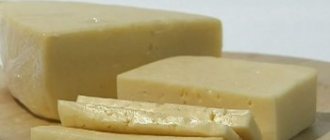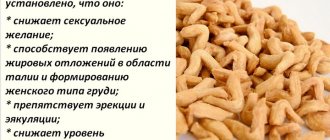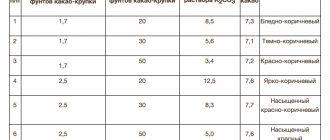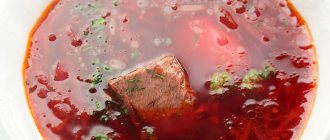Nutritional value and determination of good quality of meat[edit | edit code]
Meat sources of protein Protein content in meat: beef, chicken, fish, pork Composition of meat Names of carcass parts
Chemical composition of meat:
proteins - up to 16%, fats - 3-14%, carbohydrates - up to 1%, vitamins, mineral salts, water - 65% and extractives.
Squirrels
. Muscle tissue proteins have high nutritional value. Less valuable are connective tissue proteins containing collagen and elastin, which do not contain tryptophan.
The meat of young animals is tender and easy to digest due to its lack of mature collagen. Collagen, when heated with water, turns into glue-glutin. Consumption of foods high in collagen has a negative effect on kidney function. At the same time, glutin and gelatin, actively affecting digestion, stimulate the secretion of juices and the motor function of the stomach and intestines. The meat is easy to cook; You can prepare a wide variety of dishes and products from it.
Fats
. The color and consistency of adipose tissue depend on the type, breed, age, sex and fatness of the animal. Depending on the location of deposition, fat can be subcutaneous, internal and muscle. If fat is deposited in the form of thin layers, then the meat is called marbled; it has high taste qualities.
Meat fats contain significant amounts of saturated fatty acids with a high melting point. Lamb fat is the hardest and most difficult to digest: its melting point is 44-45°C. Beef and especially pork fats have a softer consistency and are better absorbed. In terms of biological properties, the most optimal is pork fat, which contains polyunsaturated fatty acids - including arachidonic acid, of which it contains 5 times more than beef fat.
Extractives
. They are divided into nitrogenous (carnosine, creatine, purine bases, etc.) and nitrogen-free (glycogen, lactic acid). The meat of adult animals is richer in extractive substances than the meat of young animals. The importance of extractive substances is very great in the nutrition of both healthy and sick people, since they give meat dishes a particularly pleasant taste and stimulate the activity of the digestive glands, cardiovascular and central nervous systems.
Meat is indicated for a healthy person, but it is not recommended to eat it for dinner, so as not to cause stimulation of the central nervous system (CNS), accompanied by poor sleep or disturbing dreams. For patients with pathologies of the cardiovascular and central nervous systems, the consumption of meat dishes, and especially strong rich broths, where there are especially many extractive substances, is contraindicated. At the same time, for weakened patients who do not have disorders of the named systems, as well as for those recovering, their administration is highly desirable to increase vitality.
Meat is a source of many minerals (iron, phosphorus) and some trace elements (copper, zinc, etc.).
Vitamins
. The meat contains mainly , , , B12, PP; in small quantities - , , , mainly concentrated in the internal organs (liver, kidneys).
Ripened meat is allowed to be eaten 18-24 hours after slaughter. During this time, it becomes tender, juicy, with a characteristic taste and aroma.
Meat as a food product has a number of disadvantages. It belongs to the category of perishable products and can serve as a carrier of zoonoses (anthrax, brucellosis), the cause of infectious diseases (salmonellosis), food poisoning (botulism, helminthic infestations), helminthiases (finnosis, trichinosis).
To determine the good quality and freshness of meat, in addition to assessing the organoleptic signs of freshness, organoleptic tests for freshness, an ammonia test and other studies are carried out.
Organoleptic tests for freshness[edit | edit code]
Test with a heated knife
. Heat the blade of a knife in boiling water, cut the meat to the bone, remove the blade and smell it. An unpleasant, slightly putrid smell indicates spoilage of the meat.
Test heating of meat
. Place the meat in boiling water and, after removing it, smell it - spoiled meat emits a faint unpleasant odor.
Test brew
. Cook the meat in small pieces with the lid closed. If the meat spoils, the broth will be cloudy and have an unpleasant odor.
Signs of good quality meat
| State | Appearance | Density | Fat | Smell |
| Fresh, chilled (good quality) | The surface of the mascara has a dry dry crust and does not stick to the fingers. Drying crust color: pale pink | Dense, elastic pit from indentation quickly compares | White, with a slight yellowish tint. Hard, crumbles | Pleasant, fragrant |
| Ice cream (benign) | The cut surface is smooth; the outer surface seems to be covered with frost. Color pale gray; When touched with a finger or a hot knife, a bright red spot appears. When thawed, it releases a lot of brown-red meat juice. When pressing, the hole does not level out, the fingers are abundantly moistened with juice | Dense, difficult to cut | White, with a lime tint | It has no smell until it thaws. To determine, you need to thaw a small piece or pour boiling water over it and quickly drain the water. |
| Re-frozen | The color is brick-red, uneven, sometimes bright red, sometimes blue, sometimes blue (iridescence). The color does not change with the touch of a finger. Thawed meat is flabby | Same | The fat layer on the side of the muscle fibers is brick-red in color. | Same |
Meat: lamb, beef, pork, veal. Nutritional, biological value and dietary properties
Lamb, beef, pork meat. Veal.
The Institute of Nutrition of the USSR Academy of Medical Sciences classifies the meat of large and small ruminants, pigs, rabbits and poultry as sources of first-class proteins, i.e., containing all essential amino acids in significant quantities. Meat production has always been and still remains one of the most labor-intensive and expensive branches of agriculture.
Lamb occupies a somewhat special place in dietary terms, despite the fact that this fairly common source of complete proteins has high nutritional and biological qualities. Lamb of categories I and II, respectively, contains 67.6 and 69.3 g% water, 16.3 and 20.8 g% protein, 15.3 and 9.0 g% fat (calorie content - 203 and 164 kcal per 100 g of product ); 270 and 375 mg% potassium, 60 and 75 mg% sodium, 9 and 11 mg% calcium, 18 and 22 mg% magnesium, 178 and 215 mg% phosphorus, 2.0 and 2.3 mg% iron; 0.08 and 0.09 mg% vitamin B1, 0.14 and 0.16 mg% vitamin B2, 2.5 and 2.8 mg% vitamin PP. According to many sources, cholesterol in lamb fat is 2.5 times less than in beef fat, and almost 4 times less than in pork fat. Accordingly, there is 7 and 5 times less lecithin, as well as connective tissue proteins. Another advantage of lamb is that it is more than two times less than beef and pork contains carnosine and creatine - nitrogenous extractive substances that are very undesirable for dietary nutrition, but at the same time, lamb is twice as high as beef in the content of purine bases, which are strictly are regulated in many diets.
The use of especially fatty lamb for dietary purposes is mainly limited by the nature of its fats, which are considered the most refractory. Lamb fat melts at 44-52 °C, its breakdown is associated with a relatively high voltage of digestive enzymes. In this regard, the question arises: why is lamb, practically without harm to human health, systematically and in considerable quantities consumed by the majority of the population of the Central Asian republics? And in those parts people suffer from atherosclerosis of blood vessels no more often than in Ukraine or the Baltic states.
Apparently, in this case we can talk about the importance of traditions in human nutrition and about the certain adaptation of the gastrointestinal tract to such nutrition that is formed in connection with this. It is theoretically justified and confirmed by medical practice that small irritations in magnitude and rare in frequency do not give the desired training effect. A stimulus of greater strength and without long breaks initially leads to overstrain (within physiological limits) of the trained organ, which, if such training continues, gradually ceases to be felt as excessive. Although this can often lead to a permanent decline in the performance of this organ. This fully applies to food irritants, which, as a rule, should not be weak, not strong, but optimal in all respects. Traditional nutrition for a particular area in most cases is an optimal training and supporting factor that ensures that the diet is consistent with the entire digestive system. Therefore, one of the main principles of rational and thereby preventive nutrition is moderate and at the same time systematic consumption of all commercially available food products. Let's give another example. The indigenous population of many areas of the Arctic coast of our country quite often and in relatively large quantities consume fatty meat rich in cholesterol. But atherosclerosis and other diseases accompanying it, for example, in Chukotka, in the Nenets National District, are no more common than in the Baltic states. It turned out that the bodies of the Chukchi, Nenets, and Eskimos contain more substances than usual that have an anti-cholesterol effect. At the same time, it would also be fair to note that the inhabitants of the coastal tundra, like the population of the Central Asian republics, are distinguished not only by their penchant for the traditional diet for these places, usually moderate, but also by high physical activity until old age. So people who are not accustomed to lamb should not get carried away with it, especially if a diet is prescribed by a doctor.
Beef. Bull, cow - in the Old Slavonic language “beef”. Hence the traditional name for the meat of these animals.
In beef of category I, the edible part is approximately 79%, in beef of category II and in veal - no more than 66% of the total carcass. Beef of categories I and II contains: water 67.7 and 71.7 g%, protein - 18.9 and 20.2, fat - 12.4 and 7.0 g% (calorie content - 187 and 144 kcal per 100 g of product ); potassium - 315 and 334 mg%, sodium - 60 and 65, calcium - 9 and 10, magnesium - 21 and 23, phosphorus - 198 and 210, iron - 2.6 and 2.8 mg%; vitamin B1 - 0.06 and 0.07 mg%, vitamin B2 - 0.15 and 0.18, vitamin PP - 2.8 and 3.0 mg%. Beef contains an average of 2.6 g% of low-value proteins elastin and collagen. The first of them is mainly concentrated inside the tendons, fascia, collagen - the main component of the ligamentous apparatus. Fats that accumulate directly in muscle tissue create the familiar sensation of deliciousness of a beef dish for most people and, of course, increase its calorie content.
From a nutritional point of view, excess fat in beef is undesirable, because it melts at 41-48 °C. To saponify such fat, like lamb fat, more bile is required, and to break it down, a special enzyme is required - lipase. Therefore, the liver, bile ducts and pancreas function with excess tension. In addition, refractory or hard fats make it difficult to utilize food proteins. However, it is difficult to classify lean beef as a complete dietary product, since the content of connective tissue proteins in muscle tissue increases almost 3 times and the content of water increases 2-4 times. And fats are even poorer in fusible, highly unsaturated fatty acids. Frequent inclusion of lean beef in diets is also accompanied by greater tension in gastric secretion and exocrine pancreatic function.
Therefore, for dietary purposes, beef of medium fatness is most acceptable. But it is also necessary to take into account that the nutritional value of meat from different parts of the carcass is not the same. Muscle fibers, which bear heavy loads during the life of an animal, are thicker, coarser, and their proteins are less efficiently utilized. The muscles located on both sides of the lumbar spine are a different matter. This is the softest part of the carcass - the tenderloin. For the most complete protein nutrition, it is better to use tenderloin, thin edge, sirloin, sirloin. For less strict diets, thick edge, rump and rump are quite suitable. If it is necessary to use other parts of the beef carcass for dietary purposes, then the dishes must not be portioned, but chopped - from minced meat twice or thrice ground. According to various sources, cholesterol in beef fat averages 75 mg%, and the anticholesterol factor lecithin averages 70 mg%. However, the muscle fibers themselves contain large amounts of lecithin and, equally important, quite a lot of choline and methionine. Therefore, beef has considerable lipotropic properties. 100 g of beef contains approximately 0.35 g of nitrogenous extractives. In addition to the minerals and trace elements already listed, it also contains cobalt, zinc, copper, nickel, sulfur, and manganese.
Some diets include limiting meat dishes. But most often, therapeutic nutrition is not complete without boiled beef, steamed beef cutlets, meatballs, zraz, and rolls.
Pork. Pig meat is also considered one of the important suppliers of complete proteins in the diet of a healthy, and often sick, person. According to the degree of fat content, pork is divided into meat, semi-fat and fatty. Bold pork is sometimes also called bacon. It is customary to cut a pork carcass into eight parts, each of which is divided into three grades based on nutritional value. Bacon, fat and meat pork respectively contain: water 54.8, 38.7 and 51.6 g%, proteins - 16.4, 11.4 and 14.6, fats - 27.8, 49.3 and 14, 6, ballast substances - 1.0, 0.6 and 0.8 g% (calorie content - 316, 489 and 355 kcal per 100 g of product); potassium 272, 189 and 242 mg%, sodium - 57, 40 and 51, calcium - 8, 6 and 7; magnesium - 24, 17 and 21, phosphorus - 182, 130 and 164 mg%, 1.8, 1.3 and 1.6 mg% iron; 0.60, 0.40 and 0.52 mg% vitamin B1, 0.16, 0.10 and 0.14 mg% vitamin B2, 2.6, 2.2 and 2.4 mg% vitamin PP, approximately 2 .6 mg% vitamin E. According to some information, there is less cholesterol in pork (0.07-0.1 g%) than in beef. But there are more purine bases (41 mg%) than in beef and veal, but less than in turkey and chicken carcasses. In terms of the quantity and ratio of essential amino acids, pork proteins are practically no different from beef proteins and are superior to lamb proteins in this respect. In addition, pork contains less connective tissue proteins - elastin and collagen. Pig muscle and subcutaneous fat is richer than many other fats of animal origin in highly unsaturated fatty acids, in particular one of the most biologically active - arachidonic acid. Therefore, the initial melting point of pork fat (36 °C) is ten degrees or more lower than that of lamb and beef fats. In dietary nutrition, it is possible to periodically replace boiled beef of medium fatness with boiled meat pork. First courses made with pork broth are not considered dietary.
Veal meets the most demanding dietary requirements. It contains 78.0 g% water, 19.7 g% protein, 1.2% fat (calorie content - 90 kcal per 100 g of product); 344 mg% potassium, 108 mg% sodium, 11 mg% calcium, 24 mg% magnesium, 189 mg% phosphorus, 1.7 mg% iron, certain amounts of copper, manganese, cobalt, zinc; 0.14 mg% vitamin B1, 0.23 mg% vitamin B2, 3.3 mg% vitamin PP, vitamins B6, B12, K. There are slightly more purine bases (38.5 mg%) in veal than in beef, and cholesterol - significantly less. All other things being equal, the raw muscles of a calf contain less connective tissue proteins than a cow carcass. Approximately 60% of the subcutaneous and intramuscular fat of veal consists of biologically active highly unsaturated fatty acids.
For dietary nutrition, boiled veal dishes are most acceptable. In this case, 3/4 of the nitrogen-containing extractive substances and almost all the cholesterol remain in the broth. Boiled and then lightly fried veal helps to quickly recover from infectious diseases, injuries, and burns. In this case, not only the nutritional and biological value of the dish is of great importance, but also its psychological impact. This was well understood and taken into account in their medical practice by outstanding Russian doctors N.I. Pirogov, G.A. Zakharyin, S.P. Botkin and many others.
-Source-
Evenshtein, Z.M. Popular dietetics / Z.M. Evenshtein.- M.: Economics, 1990.- 319 p.
Previous chapter ::: To contents ::: Next chapter
Post Views: 602
Red meat: harm[edit | edit code]
Posted by Dietitian Joel Fuhrman
Getting a lot of protein from animal products doesn't just speed up aging and promote cancer. Eating excessive amounts of meat is also associated with an increased risk of mortality from cardiovascular disease. For example, pooled data from the Nurses' Health Study and the Health Professionals Follow-up Study, which together followed more than 120,000 people, found that every serving of red meat per day increases the risk of death from heart disease. -vascular diseases by 18%.
Saturated fat and heme iron found in red meat have also been shown to increase the risk of heart disease. Saturated fats are known to increase total cholesterol and LDL (“bad cholesterol”) levels, and excess iron is associated with oxidative stress, which contributes to the development of atherosclerosis. Interestingly, one mechanism by which the combination of saturated fat and red meat increases the risk of developing the disease is the absorption of the heme form of iron through the consumption of saturated fat. Heme iron and saturated fat work together to oxidize cholesterol, increasing small pieces of oxidized LDL, which is what seems most dangerous. The body regulates the absorption of non-heme iron (from plant foods) if it does not currently need it, but the body absorbs heme iron from animal foods anyway. Iron is an essential mineral responsible for the transport of oxygen in the blood, as well as other important processes in the body, but an excess of iron leads to serious internal changes that reduce immunity, increasing sensitivity to chronic diseases, especially those based on the stimulation mechanism oxidative stress, for example, heart disease and cerebrovascular accidents. A recent meta-analysis confirmed the link between red, processed meat and a significant increase in the risk of ischemic stroke. Also, the heme form of iron can contribute to the overoxidation of fat present in the diet, even in the case of vegetable salad oils, so diets containing large amounts of red meat and vegetable oils may increase the risk of damage to cell membranes by such unsaturated acids caused by free radicals contained in vegetable oils. oils
What we eat determines the type of bacteria that will create microflora in our intestines.
Some studies have shown that increased consumption of meat and heme iron, among other things, is associated with high blood pressure, while consumption of non-heme iron (from plant foods) prevents its increase.
In addition, there is now even more exciting new research that has discovered another mechanism by which red and white meat increases the risk of cardiovascular disease - this happens through changes in specific bacteria that inhabit our digestive tract.
Healthy, fiber-rich plant foods provide an energy source - prebiotics, necessary for the growth of beneficial bacteria. For example, carnitine, an amino acid found in abundance in animal foods, is virtually absent in plant foods. The human body is able to produce adequate amounts of carnitine from the other amino acids lysine and methionine. Carnitine is necessary for body cells to transport fatty acids. This mechanism was first discovered in mice when scientists determined that carnitine in the diet was produced by gut bacteria that produced trimethylamine N-oxide. This substance, as previously established, contributes to the development of atherosclerotic plaques, as it slows down the process of removing cholesterol from the arterial wall. Later, after analyzing the levels of carnitine and trimethylamine-N-oxide in people's blood, the same researchers found that high levels of both compounds increased the likelihood of cardiovascular disease, as well as the risk of heart attack and stroke. When a group of people in a study were given carnitine supplements, those who ate all foods released more trimethylamine-N-oxide than vegans and vegetarians. Additionally, it is worth noting that the types of gut bacteria found in omnivores were different from those found in vegetarians and vegans. The findings suggest that eating meat promotes the growth of gut bacteria that can convert carnitine into substances that contribute to heart disease.
Findings like these suggest that those of us who regularly eat a healthy diet consisting of mostly whole, plant-based foods have healthier gut flora and are less susceptible to problems associated with carnitine deficiency. Most studies to date show a causal link between meat consumption and cancer and premature death, leaving no doubt that even meat from animals raised in favorable conditions should be avoided or minimized in the diet. If you do not intend to eliminate meat from your diet, then you should only use it as a supplement; that is, only a few times a week and in small quantities.
Avoid processed meats, which include sliced meats, bologna, jerky, bacon, snack meats, hot dogs and pizza meats that are canned or packaged.
The calorie content of human flesh indicated the inadvisability of cannibalism for food
America tertia pars, Theodor de Bry, 1592
Biblioteca Mário de Andrade / Public Domain
British researcher James Cole calculated the energy value of the body of modern humans and the closest extinct representatives of the genus Homo
as a food product and compared these data with the living conditions of the Paleolithic era.
Based on these data, he concluded that the repeatedly documented cannibalism of ancient people was inappropriate from a food point of view and, most likely, had other reasons. The scientist shares his reasoning on the pages of the journal Scientific Reports
.
Archaeological evidence of cannibalism (primarily bone damage characteristic of carcass dissection and flesh removal) among ancient hominins is relatively rare, but it covers a wide geography and time period of approximately 900 thousand years. Precise explanations for the purposes of such practices are difficult to provide; it is most often assumed that the main ones were famine, aggression between groups and death rituals.
Cole, who works at the University of Brighton, decided to assess how caloric and therefore valuable the human body is as a food resource. To do this, he analyzed published data on the complete chemical composition of all organs of four modern adult men. It turned out that the body of a man weighing 66 kilograms contains a total of about 144 thousand kilocalories, or, if we take into account only the body parts usually eaten by cannibals, about 126 thousand kilocalories. The energy value of individual organs and tissues is shown in the diagram.
Calorie content of human organs and tissues
James Cole / Scientific Reports, 2017
Share
The scientist then compared these data with estimated body masses (on average, they turned out to be significantly less than modern ones) and the total number of people supposedly eaten from nine archaeological sites dating from more than 900 thousand to about 14 thousand years ago. Five of them were sites of Neanderthals, two of sapiens, and two more of other extinct human species. Cole also added to the analysis the energy value of the animals whose remains were in these sites.
It turned out that a kilogram of meat from large animals, such as mammoth, bull or bison, contains about 2000, and human meat - only about 1300 kilocalories. A summary analysis of the data showed that, on average, a human body eaten from the excavation could provide food for a group of 25 people for about half a day. Moreover, for an average mammoth (3.6 million kilocalories) this figure is 60 days, and for a bison (612 thousand kilocalories) - 10 days. At the same time, hunting relatives with similar intelligence, fighting skills and weapons is much more difficult and energy-consuming than collectively hunting large wild animals.
From these data, Cole concluded that cannibalism as a food source had little practical survival value, and was unlikely to be regularly practiced as such. In his opinion, eating the bodies of relatives for gastronomic purposes could only occur in isolated cases, for example, during skirmishes with neighboring tribes, from which corpses remained. However, the main reasons for cannibalism in the Stone Age were most likely social, cultural and ritual, the scientist believes.
Experts in the field of paleoanthropology generally recognized Cole's calculations as interesting, however, according to most of them, the interpretation of the results should be approached with caution due to the small amount of data, and conclusions about the purpose of cannibalism cannot be called final and fundamental.
Previously, scientists discovered that Northern European Neanderthals not only ate their dead relatives for food, but also used their bones to create tools.
Oleg Lishchuk
Grilled meat[edit | edit code]
Source Muscle and Fitness Magazine No. 2
Pump more protein into your muscles with a simple device
In the summer everything is clear. You buy fresh meat at the market and go to the forest for a picnic. There you build a fire and cook excellent barbecue. What about in winter? Fry meat in a frying pan? In no case! Get an electric grill at home. You won't believe it, but many versions of this electric device are so successful that they cook meat indistinguishable from an open fire. The home grill is compact and can easily fit in a modern kitchen, or even on a loggia. As a result, you will have delicious steaks on the table all year round. As for the recipes, here they are!
Dietary meat dishes
Dietary meat dishes can be divided into several large groups. Firstly, these are dishes for overweight people. When choosing meat for such dishes, the decisive factor will be the calorie content of the meat: the lower it is, the better.
Secondly, dietary dishes for people suffering from liver and pancreas diseases. They should be low-fat and easily digestible. To prepare dietary meat dishes for such patients, it is preferable to use veal, chicken, young horse meat, and rabbit.
For those who have low blood cholesterol levels, any meat except pork is suitable. It is desirable that it be meat from young animals.
For patients with peptic ulcers, dietary meat dishes should not be too fatty and have a delicate consistency . Meat soufflés, steamed meatballs or cutlets are preferable. How many calories meat contains is not important if the patient is not overweight.
For baby food, choose types of meat with a high content of easily digestible protein: veal, young beef and lamb, rabbit, chicken. If the child is not overweight or has a tendency to become overweight, then the calorie content of meat is of secondary importance.
Serving[edit | edit code]
Beans[edit | edit code]
Although potatoes are traditionally served with beef, this is far from the best side dish. It slows down the digestion of meat and makes the dish “heavy”. Meat should be served with a small amount of carbohydrates, which are relatively easy to digest. These include canned legumes: peas, beans and lentils. First, the beans are drained and then boiled in boiling water for 10-15 minutes with the addition of onion and bay leaf. Then the bay leaf is removed and the beans are mashed into a puree. Pepper the puree on top and sprinkle with grated cheese. INGREDIENTS [1 cup beans]: 245 calories, 15 g protein, 45 g carbohydrates, 1 g fat.
Homemade chips[edit | edit code]
Pour 1 cup of vegetable oil into a deep frying pan. Heat oil over medium heat. Cut the finished corn tortilla into small triangles. Place the tortilla pieces in the pan and submerge completely in the oil. Cook in hot oil for about 1 minute, then place on a paper towel to drain. Sprinkle salt on top. COMPOSITION (12 pieces): 140 calories, 0 g protein, 19 g carbohydrates, 6 g fat.
Spanish Rice[edit | edit code]
Pour 2 cups of water into a deep frying pan, add a chicken broth cube, 1 teaspoon of grated garlic, 1 teaspoon of onion powder, add a pinch of cinnamon and pour in 1 tbsp. spoon of spicy tomato sauce (salsa). Mix well and boil for 5 minutes. Add a little olive oil to a small saucepan. Chop the onion and add the onion to the pan. Add 1 cup of dry rice there and keep on low heat for 5 minutes. Then dump the contents of the pan into the pan and stir. Cover the pan with a tight lid and place over low heat for 30 minutes. The secret of the dish is not to open the lid during this period. As a result, the rice will turn out incredibly fragrant. Salt the finished rice to taste. COMPOSITION (250 g rice): 250 calories, 4 g protein, 45 g carbohydrates, 7 g fat.









